Odekon M. Encyclopedia of paleoclimatology and ancient environments
Подождите немного. Документ загружается.

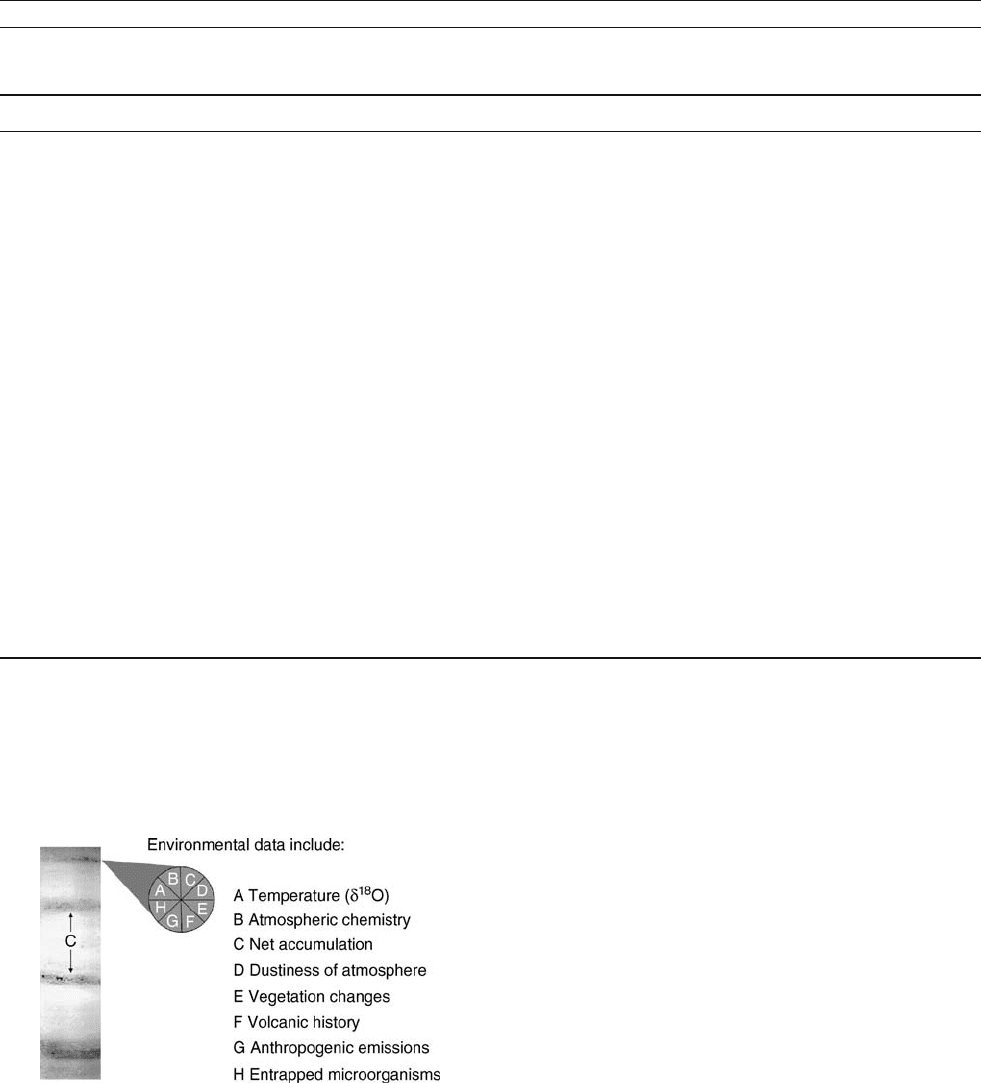
the fractionation of the oxygen and hydrogen atoms into their
light and heavy isotopes (
16
O and
18
O,
1
H and
2
H or deuterium
(D)), and on the higher vapor pressure of H
2
16
O over HD
16
O
and H
2
18
O. The resulting ratios of the light and heavy isotopes
of these elements act as recorders of temperature both at the
moisture source and at the deposition site.
The use of d
18
O and dD as temperature proxies for polar ice
is now widely accepted; however, it is still a source of contro-
versy for lower-latitude cores. Some who have studied the pro-
blem suggest that d
18
O, rather than being a temperature
recorder at lower latitudes, is a function of precipitation amount
(Rozanski et al., 1993; Dahe et al., 2000; Shichang et al., 2000;
Baker et al., 2001; Tian et al., 2001). However, real-time com-
parisons of air temperature and d
18
O measured on precipitation
on the Northern Tibetan Plateau reveal a very close relationship
between the two (Yao et al., 1996). Correlations between ice
core records from the Himalayas and the Northern Hemisphere
temperature records show that on longer time scales (longer
than annual) the dominant factor controlling mean d
18
O values
in snowfall must be temperature rather than precipitation
(Thompson et al., 2000; Davis and Thompson, 2003). On sea-
sonal to annual time scales, both temperature and precipitation
influence the local d
18
O signal (Vuille et al., 2003).
The annual precipitation rate on an ice cap, or net balance,
can be reconstructed by measuring the length of ice between
seasonal variations in one or more parameters (e.g., d
18
O
indicating warm or cold seasons or high aerosol concentrations
characterizing dry seasons, Figure I4) Since ice is viscous, it
Figure I4 A large variety of environmental information can be obtained
from high-altitude ice cores. On the left is an image of a core from a
typical mountain glacier in Tibet. The dust bands were deposited
during the dry seasons, and the space between them is cleaner ice from
snow deposited during the wet seasons.
Table I3 A sampling of mountain glaciers sites from which ice cores have been retrieved since 1980. This is by no means a complete inventory of all
alpine ice cores ever collected
Mountain Location Elevation (m a.s.l.) Year drilled Leading organization Length of core (m) Length of record (yr)
Bona Churchill 61
24
0
N, 141
42
0
W 4,420 2002 BPRC 460 1700
Mt. Logan 60
35
0
N, 140
35
0
W 5,340 1980 NHRI 103 225
2002 NGP, AINA
NIPR
190 NA
220 NA
IQCS, UNH 345 NA
Eclipse Dome 60
51
0
N, 139
47
0
W 3,017 1996 UNH 160 NA
Fremont Glacier 49
07
0
N, 109
37
0
W 4,100 1991 USGS 160 275,
1998 50, 160 NA
Belukha 49
48
0
N, 86
34
0
E 4,062 2001 PSI, UNIBE 140 200+
Fiescherhorn 46
32
0
N, 8
02
0
E 3,880 1988 PSI, UNIBE 30 42
2002 150
Coropuna 15
32
0
S, 72
39
0
W 6,450 2003 BPRC 146.3, 34.3, 34.3 16,000+
Col du Dôme 45
50
0
N, 6
50
0
E 4,250 1994 LGGE, IFU 139 75
Mont Blanc 45
45
0
N, 6
50
0
E 4,807 1994 LGGE 140 200+
Djantugan 43
12
0
N, 42
46
0
E 3,600 1983 IGRAS 93 57
Gregoriev 41
58
0
N, 77
55
0
E 4,660 1991 IGRAS, BPRC 20, 16 53
2001 IGRAS 21.5 NA
2003 IGRAS 22 NA
Dunde 38
06
0
N, 96
24
0
E 5,325 1987 BPRC, LIICRE 138 10,000+
Malan 35
50
0
N, 90
40
0
E 6,056 1999 LIICRE 102 112+
Guliya 35
17
0
N, 81
29
0
E 6,200 1992 BPRC, LIICRE 302 110,000+
Puruogangri 33
55
0
N, 89
05
0
E 6,000 2000 BPRC, LIICRE 208 7000
Dasuopu 28
23
0
N, 85
43
0
E 7,200 1996 BPRC, LIICRE 162 1,000+
Qomolangma 27
59
0
N, 86
55
0
E 6,500 1998 UNH, LIICRE 80 154
Kilimanjaro 3
04
0
S, 37
21
0
E 5,895 2000 BPRC 52 11,700
Huascarán 9
06
0
S, 77
36
0
W 6,050 1993 BPRC 166 19,000
Quelccaya 13
56
0
S, 70
50
0
W 5,670 1983 BPRC 155, 164
168, 129
1,500
17802003
Illimani 16
37
0
S, 67
47
0
W 6,350 1999 IRD, PSI 137, 139 18,000
Sajama 18
06
0
S, 68
53
0
W 6,540 1996 BPRC 132 20,000
NA: Data not available.
Abbreviations: BPRC, Byrd Polar Research Center, The Ohio State University (USA); NHRI, National Hydrology Research Institute (Canada); NGP,
National Glaciology Program (Canada); AINA, Arctic Institute of North America, University of Calgary (Canada); NIPR, National Institute of Polar
Research (Japan); IQCS, Institute for Quaternary and Climate Studies, University of Maine (USA); USGS, United States Geological Survey (USA);
PSI, Paul Scherrer Institute (Switzerland); IRD, Institute of Research and Development (France); LGGE, Laboratoire de Glaciologie et Geophysique de
l’Environnement (France); IGRAS, Institute of Geography, Russan Academy of Science (Russia); IFU, Institut für Umweltphysik (Germany); UNIBE, Uni-
versity of Bern (Switzerland); LIICRE, Key Laboratory of Ice Core and Cold Regions Environment (China); UNH, Institute for the Study of Earth, Oceans
and Space, University of New Hampshire (USA).
458 ICE CORES, MOUNTAIN GLACIERS

tends to flow not only horizontally but also vertically, resulting
in annual layer thinning with depth. In order to correct for this
deformation and reconstruct the original thickness of an annual
layer at the time of its deposition in the past, vertical strain
models are used that take into account the changing densities
with depth, the thickness of the glacier, and the rate of thinning
(Bolzan, 1985; Reeh, 1988; Meese et al., 1994).
Aerosols in the atmosphere are either deposited on mountain
ice fields and glaciers as nuclei of snow (wet deposition) or car-
ried by turbulent air currents to high altitudes (dry deposition).
Either way, these insoluble mineral dust particles and soluble
salts, such as chlorides, record variations in environmental con-
ditions such as regional aridity. The concentration and size
distribution of insoluble dust particles are also helpful for qua-
litative reconstructions of wind strength. Evidence of volcanic
eruptions in the ice is provided by sulfate concentrations and/
or the presence of microscopic tephra particles. If these volca-
nic layers are identifiable (e.g., the 1815 eruption of Tambora
or the 1883 eruption of Krakatoa), they can serve as valuable
reference horizons to calibrate the time scale. Biological aero-
sols, such as pollen grains (Liu et al., 1998) and nitrates that
may have been injected into the atmosphere by vegetation
upwind of a glacier (Thompson et al., 1995; Thompson,
2000), have been useful for reconstructing past climate and
environmental changes that have had impacts on regional flora.
The record of human activity is also available from ice cores,
although this type of research on high-altitude glaciers lags
behind polar ice sheets. Research on heavy metal types and con-
centrations in high-altitude glaciers is relatively new, but what is
available from Mont Blanc in the French-Italian Alps provides
information about increasing industrial production and other
activities associated with expanding populations and urbaniza-
tion (Van DeVelde et al., 1999). Measurements of carbon diox-
ide and methane, as well as lesser gases, trapped in ice bubbles
are not as extensive on ice from mountain glaciers as they are
from polar cores; however, the research that has been done
shows correlations of so-called “greenhouse” gas concentrations
with the temperature proxy d
18
O (Yao et al., 2002a, b). The
information from these ice core studies complements other
proxy records that compose the Earth’s climate history, which
is the ultimate yardstick by which the significance of present
and projected anthropogenic effects will be assessed.
The significance of climate records from mountain
glaciers
Ice core records from high-altitude glaciers, when combined
with high-resolution proxy histories such as those from tree
rings, lacustrine and marine cores, corals, etc., provide an
unprecedented view of the Earth’s climatic history that can
extend over several centuries or millennia. The longest of them
have revealed the nature of climate variability since the Last
Glacial Maximum (LGM), 18–20 thousand years ago, and
even beyond. The more recent parts of the climate records,
which are of annual and even seasonal resolution, can yield
high-resolution temporal variations in the occurrence and inten-
sity of coupled ocean-atmosphere phenomena such as El Niño
and monsoons, which are most strongly expressed in the tro-
pics and subtropics, and are of world-wide significance. This
is particularly valuable information since meteorological obser-
vations in these regions are scarce and of short duration.
Four records from the Andes (Huascarán in Northern Peru,
Coropuna in Southern Peru and Sajama and Illimani in Bolivia)
and one from the Western Tibetan Plateau (Guliya) extend to or
past the end of the last glacial stage and confirm, along with
other climate proxy records (e.g., Guilderson et al., 1994; Stute
et al., 1995), that the LGM was much colder in the tropics and
subtropics than previously believed. Although this period was
consistently colder, it was not consistently drier through the
lower latitudes as it was in the polar regions. For example,
the effective moisture along the axis of the Andes Mountains
during the end of the last glacial stage was variable, being
much drier in the north than in the Altiplano region in the
central part of the range (Thompson et al., 1995, 1998; Ramirez
et al., 2003). In another example in Western China, the Guliya
Ice Cap is partly affected by the variability of the southwest
Indian monsoon system, which was much weaker during
the last glacial stage than during the Holocene. However, this
region of the Tibetan Plateau also receives (and received)
moisture generated from the cyclonic activity carried over
Eurasia by the prevailing wintertime westerlies. Not only were
lake levels in the Western Kunlun Shan higher than tropical
lakes during the LGM (Li and Shi, 1992), but the dust concen-
trations in the Guliya ice core record were consistent with those
of the Early Holocene when the summer Asian monsoons
became stronger, suggesting that local sources of aerosols were
inhibited during this cold period by higher precipitation and
soil moisture levels (Davis, 2002).
Ice cores from the Andes can also contribute to what is
known about past environmental and climatic conditions of
the Amazon Basin. The extent of biological activity in the
Amazon rainforest during the LGM is controversial, and the
nitrate concentration record from the Huascarán ice core has
been included in the argument (Colinvaux et al., 2000). Pollen
studies from the Amazon Basin suggest that the extent of the
rainforest has not changed much between the glacial maximum
and the Holocene. However, proponents of the “refugia” theory
(i.e., Clapperton, 1993) assert that the cold, dry climate in the
tropics caused a major retreat of the rainforest flora into a
small, geographically isolated area, leaving most of the Basin
covered by grasslands. In the Huascarán core, the nitrate con-
centration profile is similar to the d
18
O levels throughout most
of the record, and the very low concentrations of nitrate, which
are concurrent with very depleted d
18
O, suggest that biological
activity upwind of the Cordillera Blanca was impeded by the
cold and dry climate 19,000 years ago.
Most of the deep cores from the low latitudes extend
through at least the Holocene, and show spatial variations in
climate, even between records from the same region. For exam-
ple, the Holocene d
18
O profiles from Huascarán and Illimani,
while similar to each other in that they show Early Holocene
isotopic enrichment, are different from that on Sajama, which
has a relatively stable isotopic record through the last 10,000
years. Although Sajama and Illimani, both in Bolivia, are geo-
graphically close to each other, they are on opposite sides of
the Andean Mountains, with Illimani located in the eastern
range. Like Huascarán far to the north, it received most of its
precipitation from the northeast after it had been recycled
through the Amazon Basin. Sajama, which is located on the
high, dry Altiplano, is more subject to Pacific influences and
local hydrological effects.
Holocene ice core records from mountain glaciers around
the world show evidence of major climatic disruptions, such
as droughts and abrupt cold events during this period, which
previously was believed to have been stable. Major dust events,
beginning between 4.2 and 4.5 ka and lasting several hundred
years, are observed in the Huascarán and Kilimanjaro ice cores
ICE CORES, MOUNTAIN GLACIERS 459
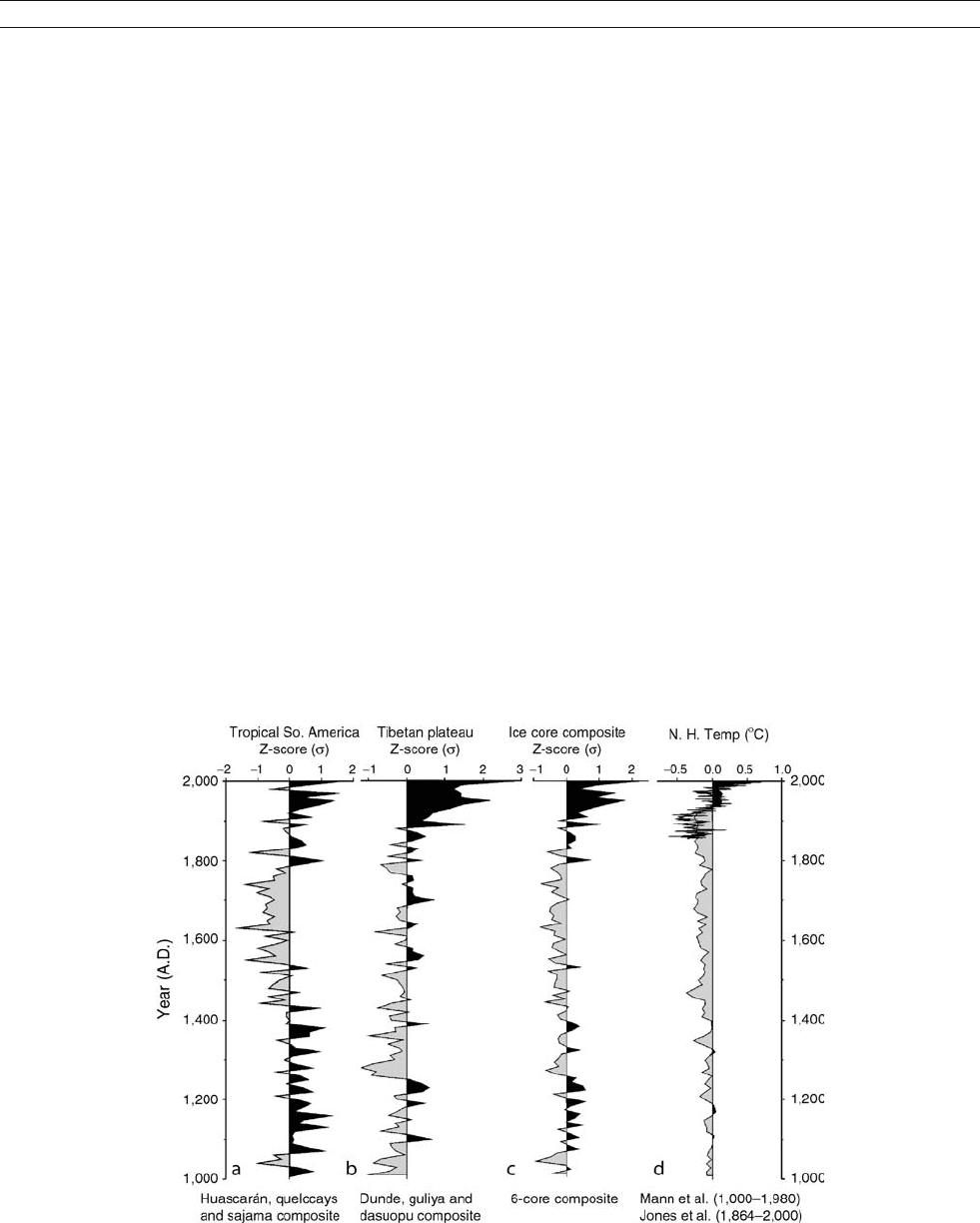
(Thompson, 2000; Thompson et al., 2002, respectively), and
the timing and character of the dust spikes are similar to one
seen in a marine core record from the Gulf of Oman (Cullen
et al., 2000) and a speleothem d
13
C record from a cave in Israel
(Bar-Matthews et al., 1999). This dry period is also documen-
ted in several other proxy climate records throughout Asia
and Northern Africa (see contributions in Dalfes et al., 1994).
Two other periods of abrupt, intense climate change in east
Africa are observed in the Kilimanjaro ice core at 8.3 ka
and 5.2 ka (Thompson et al., 2002). The latter event is asso-
ciated with a sharp decrease in d
18
O, indicative of a dramatic
but short-term cooling.
More recently, a historically documented drought in India in
the 1790s, which was associated with monsoon failures and a
succession of severe El Niños, was recorded in the insoluble
and soluble aerosol concentration records in the Dasuopu
ice core (Thompson et al., 2000). Another recorded Asian
Monsoon failure in the late 1870s (Lamb, 1982) is noticeable
in the Dasuopu dust flux record, which is a calculation that
incorporates both the dust concentration and the annual net bal-
ance. The dust concentration on Dasuopu is also linked to the
magnitude of the Southern Oscillation and the phase of the
Pacific Decadal Oscillation (Davis, 2002), thus indicating a
linkage between these tropical processes. However, recent
research on Tibetan Plateau ice cores drilled north of 32
N
shows that their climate records are not only influenced by
the South Asian Monsoon and other tropical coupled atmo-
spheric-oceanic processes such as the El Niño-Southern Oscil-
lation (ENSO), but also by atmospheric pressure variations
such as those seen in the North Atlantic Oscillation (Davis
and Thompson, 2003; Wang et al., 2004). Thus, the high reso-
lution isotope, chemistry, dust, and accumulation records from
ice cores retrieved from across the Plateau help us to recon-
struct the spatial and temporal variability of the climate in this
region.
There is little purpose in trying to reconstruct the history of
global climate change from one ice core, especially at high
resolution on short time scales. However, as discussed above,
it is clear that certain parameters such as d
18
O do record
large-scale regional variability in sea surface temperatures,
while others such as aerosols may be more sensitive to local
as well as regional conditions. Although the mountain ice core
records that extend back through the last millennium show
regional differences with each other and with the polar records,
many of them also document common climatic variations on
hemispheric, and even global, scales. This is illustrated in
Figure I5, where composites of the decadally-averaged d
18
O
profiles of three South American cores (Huascarán, Quelccaya,
and Sajama) and three Tibetan Plateau cores (Dunde, Guliya and
Dasuopu) show different interhemispheric trends (Thompson
et al., 2003)(Figures I5a and I5b, respectively). For example,
the “Little Ice Age,” a cold event between the fifteenth and nine-
teenth centuries that is recorded in many Northern European
climate records, is more evident in the South American ice core
composite than in the Tibeta n Plateau. The “Medieval Warming,”
a period before the “Little Ice Age,” which appears in the
Greenland ice core records, is also obvious in the Andean ice
cores. However, both the composites show isotopic enrichment
(indicating warming) beginning in the late nineteenth century
and accelerating through the twentieth century. When all six
of the profiles from these mountain glaciers are combined,
the resulting composite (Figure I5c) is similar to the Northern
Hemisphere temperature records of Mann et al. (1998) and
Jones et al. (1998) covering the last 1,000 years (Figure I5d).
Figure I5 Composite records of decadal averages of d
18
O from ice cores from (a) the South American Andes (Huascara
´
n, Quelccaya, Sajama) and
(b) the Tibetan Plateau (Dunde, Guliya and Dasuopu) from 1000
AD to the present. All six ice-core records are combined (c) to give a total
view of variations in d
18
O over the last millennium in the tropics, which is compared with the Northern Hemisphere reconstructed temperature
record (d) (from Thompson et al., 2003).
460 ICE CORES, MOUNTAIN GLACIERS
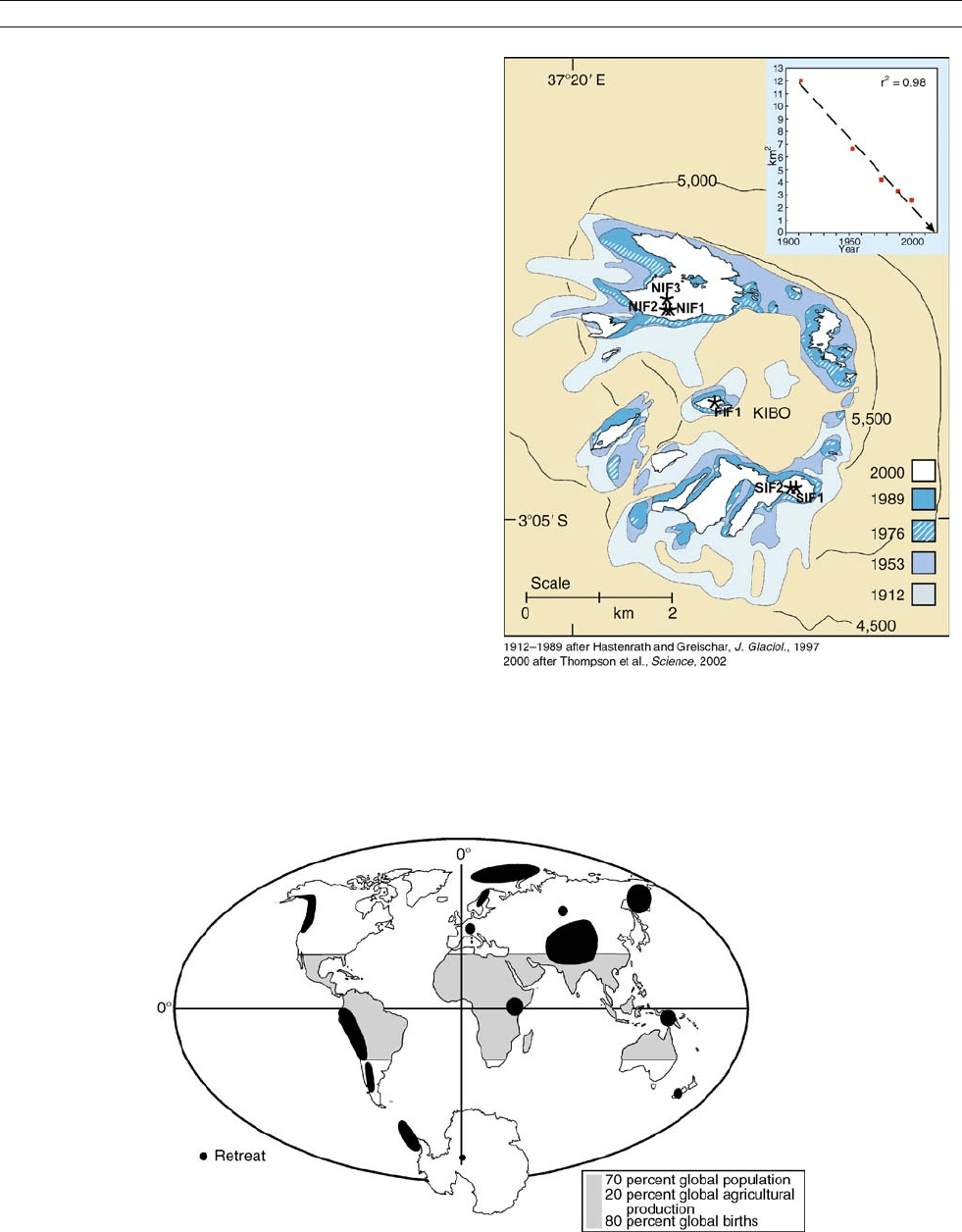
Not only do these comparisons argue for the important role of
temperature in the composition of oxygen isotopic ratios in gla-
cier ice, but they also demonstrate that the abrupt warming
from the late nineteenth century through the twentieth century
(and continuing into this century) transcends regional varia-
tions, unlike earlier climatic variations. Indeed, on a global
basis, the twentieth century was the warmest period in the last
1,000 years, which also encompasses the time of the “Medieval
Warming.”
The modern climate warming and its effects on
mountain glaciers
Meteorological data from around the world suggest that the
Earth’s globally averaged temperature has increased 0.6
C
since 1950. The El Niño year of 1998 saw the highest globally
averaged temperatures on record, while 2002 (a non-El Niño
year) was the second warmest, followed by 2003 and 2001 (a
la Niña year). The recent warming of the past century, which
has been accelerating in the last two decades, is recorded in
alpine glaciers in other ways, both within the ice core records
and by the rapid retreat of many of the ice fields. This glacier
retreat is observed in almost all regions, from the Caucasus
and other Eurasian mountain ranges in the mid-latitudes
(Mikhalenko, 1997), to central Europe and western North
America (Huggel et al., 2002; Meier et al., 2003), and to the
Tibetan Plateau and the tropics (Thompson et al., 1993; Dahe
et al., 2000; Thompson et al., 2000). In the Andes, on the
Tibetan Plateau and in the East Africa Rift Valley region, this
climate change has left its mark. The many ice fields on
Kilimanjaro covered an area of 12.1 km
2
in 1912, but today
only 2.6 km
2
remains (Figure I6). If the current rate of retreat
continues, the perennial ice on this mountain will likely disap-
pear within the next 20 years (Thompson et al., 2002).
Future priorities
Ice cores from mountain glaciers, especially those from the
tropical and subtropical latitudes where most of the world’s
Figure I6 Retreat of ice fields in the Kibo Crater of Kilimanjaro,
Tanzania. Shaded areas show “snapshots” of areas of ice cover at five
times over the twentieth Century. At the rate of retreat shown here, all
the ice on this mountain will disappear within the first half of the
twenty first century (insert) (from Thompson et al., 2002).
Figure I7 Map demonstrating the current condition of the Earth’s cryosphere. Dark shading depicts regions where glacier retreat is underway. The
light shading represents over land between 30
N and 30
S.
ICE CORES, MOUNTAIN GLACIERS 461

population is concentrated, provide unique and valuable
archives of climate information because they are able to record
variations in atmospheric chemistry and conditions. Since
1982, the El Niño-Southern Oscillation phenomenon has
gained worldwide attention as populations and governments
have come to realize the extent of its widespread and often
devastating effects on weather. As we begin to understand
how this coupled atmospheric-oceanic process works, we also
see its linkages with other important systems such as the
Asian/African Monsoons. Because both of these tropical sys-
tems influence precipitation and temperature over large regions,
their effects are also recorded by the chemistry and the amount
of snow that falls on alpine glaciers. Seasonal and annual reso-
lution of chemical and physical parameters in ice core records
from the Andes Mountains has allowed reconstruction of the
variability of the ENSO phenomenon over several hundred years
(Thompson et al., 1984, 1992;Henderson,1996; Henderson
et al., 1999). Because the effects of El Niño and La Ni ña
events are spatially variable, ice core records from the north-
ernmost (Colombia) and southernmost (Patagonia) reaches
of the Andes Mountains will help further resolve the fre-
quency and intensity of ENSO, along with temperature varia-
tions, from long before human documentation. This will aid in
placing the modern climate changes and the modern ENSO
into a more comprehensive perspective. Variability of the
South Asian Monsoon i s also of vital importance for a large
percentage of the w orld’s population that lives in the affected
areas. Cores from the Tibetan Plateau have yielded millennial-
scale histories of monsoon variability across this large region
and information on the interaction between the monsoon sys-
tem and the prevailing westerlies that are traced back to the
Atlantic Ocean.
The clearest evidence for major climate warming underway
today comes from the mountain glaciers, recorded in both the
ice core records and in the drastic reductions in both total area
and total volume. The rapid retreat causes concern for two rea-
sons. First, these glaciers are the world’s “water towers,” and
their loss threatens water resources necessary for hydroelectric
production, crop irrigation and municipal water supplies for
many nations. The ice fields constitute a “bank account” that
is drawn upon during dry periods to supply populations down-
stream. The current melting is cashing in on that account,
which was built over thousands of years but is not currently
being replenished. As Figure I7 illustrates, almost all the
Earth’s mountain glaciers are currently retreating. The land
between 30
N and 30
S, which constitutes 50% of the global
surface area, is home to 70% of the world ’ s population and
80% of the world’s births. However, only 20% of the global
agricultural production takes place in these climatically sensi-
tive regions. The second concern arising from the disappear-
ance of these ice fields is that they contain paleoclimatic
histories that are unattainable elsewhere and, as they melt, the
records preserved therein are forever lost. These records are
needed to discern how climate has changed in the past in these
regions and to assist in predicting future changes.
Lonnie G. Thompson
Bibliography
Baker, P.A., Seltzer, G.O., Fritz, S.C., Dunbar, R.B., Grove, M.J., Tapia,
P.M., Cross, S.L., Rowe, H.D., and Broda, J.P., 2001. The history of
South American tropical precipitation for the past 25,000 years.
Science, 291, 640–643.
Bar-Matthews, M., Ayalon, A., Kaufman, A., and Wasserburg, G.J., 1999.
The Eastern Mediterranean paleoclimate as a reflection of regional
events: Soreq Cave, Israel. Earth Planet. Sci. Lett., 166,85–95.
Bolzan, J.F., 1985. Ice flow at the Dome C ice divide based on a deep tem-
perature profile. J. Geophys. Res., 90(D5), 8111–8124.
Clapperton, C., 1993. Quaternary Geology and Geomorphology of South
America, Amsterdam, The Netherlands: Elsevier, 779pp.
Colinvaux, P.A., DeOliveira, P.E., and Bush, M.B., 2000. Amazonian
and neotropical plant communities on glacial time-scales: The
failure of the aridity and refuge hypotheses. Quaternary Sci. Rev., 19,
141–170.
Cullen, H.M., deMenocal, P.B., Hemming, S., Hemming, G., Brown, F.H.,
Guilderson, T., and Sirocko, F., 2000. Climate change and the collapse
of the Akkadian empire: Evidence from the deep sea. Geology, 28,
379–382.
Dahe,Q., Mayewski, P.A., Wake, C.P., Shichang, K., Jiawen, R.,
Shugui, H., Tandong, Y., Qinzhao, Y., Zhefan, J., and Desheng, M.,
2000. Evidence for recent climate change from ice cores in the central
Himalaya. Ann. Glaciol., 31, 153–158.
Dalfes, H.N., Kukla, G., and Weiss, H. (eds.). 1994. Third Millennium BC
Climate Change and Old World Collapse. Berlin: Springer, 723pp.
Dansgaard, W., 1961. The isotopic composition of natural waters with spe-
cial reference to the Greenland Ice Cap. Meddelelsr øm Grønland, 165,
1–120.
Davis, M.E., 2002. Climatic Interpretations of Eolian Dust Records from
Low-Latitude, High-Altitude Ice Cores, The Ohio State University:
PhD Thesis.
Davis, M.E., and Thompson, L.G., 2004. Four centuries of climatic varia-
tion across the Tibetan Plateau from ice-core accumulation and d
18
O
records. In Cecil, L.D., Thompson, L.G., Steig, E.J., and Green, J.R.
(eds.), Earth Paleoenvironments: Records Preserved in Mid and Low
Latitude Glaciers. New York: Kluwer, pp 145–162.
Guilderson, T.P., Fairbanks, R.G., and Rubenstone, J.L., 1994. Tropical
temperature variations since 20,000 years ago: Modulating inter-
hemispheric climate change. Science, 263, 663–665.
Hastenrath, S., and Greischar, L., 1994. Gacier recession on Kilimanjaro,
East Africa, 1912–89. J. Glaciol. 43, 455–459.
Henderson, K.A., 1996. The El Niño-Southern Oscillation and other modes
of Interannual Tropical Climate Variability as Recorded in Ice Cores
from the Nevado Huascarán col, Peru, The Ohio State University:
M.S. Thesis.
Henderson, K.A., Thompson, L.G., and Lin, P.-N., 1999. Recording of
El Niño in ice core d
18
O records from Nevado Huascarán, Peru. J. Geo-
phys. Res., 104(D24), 31053–31065.
Huggel, C., Kaab, A., Haeberli, W., Teysseire, P., and Paul, F., 2002.
Remote sensing based assessment of hazards from glacier lake out-
bursts: A case study in the Swiss Alps. Can. Geotech. J., 39(2),
316–330.
Jones, P.D., Briffa, K.R., Barnett,T.P., and Tett, S.F.B., 1998. High-
resolution palaeoclimatic records for the last millennium: Interpretation,
integration and comparison with general circulation model control-run
temperatures. Holocene, 8, 455–471.
Lamb. H.H., 1982. Climate History and the Modern World, London, UK:
Methuen, 387pp.
Li, S., and Shi, Y., 1992. Glacial and lake fluctuations in the area of
the west Kunlun Mountains during the last 45,000 years. Ann. Glaciol.,
16,79–84.
Liu, K.B., Yao, Z., and Thompson, L.G., 1998. A pollen record of
Holocene climate changes from the Dunde ice cap, Qinghai-Tibetan
Plateau. Geology, 26(2), 135–138.
Mann, M.E., Bradley, R.S., and Hughes, M.K., 1998. Global-scale
temperature patterns and climate forcing over the past six centuries.
Nature, 392, 779–787.
Meese, D.A., Gow, A.J., Grootes, P., Mayewski, P.A., Ram, M.,
Stuiver, M., Taylor, K.C., Waddington, E.D., and Zielinski, G.A.,
1994. The accumulation record from the GISP2 core as an indi-
cator of climate change t hroughout the Holocene. Scienc e, 266,
1680–1682.
Meier, M.F., Dyurgerov, M.B., and McCabe, G.J., 2003. The health of
glaciers: Recent changes in glacier regime. Clim. Change, 59(1–2),
123–135.
Mikhalenko, V.N., 1997. Changes in Eurasian glaciation during the past
century: Glacier mass balance and ice-core evidence. Ann. Glaciol.,
24, 283–287.
462 ICE CORES, MOUNTAIN GLACIERS

Ramirez, E., Hoffmann, G., Taupin, J.D., Francou, B., Ribstein, P., Caillon,
N., Ferron, F.A., Landais, A., Petit, J.R., Pouyaud, B., Schotterer, U.,
Simoes, J.C., and Stievenard, M.A., 2003. A new Andean deep ice core
from Nevado Illimani (6,350 m), Bolivia. Earth Planet. Sci. Lett., 212
(3–4), 337–350.
Reeh, N., 1988. A flow-line model for calculating the surface profile and
the velocity, strain-rate, and stress fields in an ice sheet. J. Glaciol. ,
34(116), 46–54.
Rozanski, K., Araguás-Araguás, L., and Gonfiantini, R., 1993. Isotopic pat-
terns in modern global precipitation. In Swart, P.K., Lohmann, K.C.,
McKenzie, J., and Savin, S. (eds.), Climate Change in Continental Iso-
topic Records. Washington, D.C.: American Geophysical Union,
pp. 1–36.
Shichang, K., Wake, C.P., Dahe, Q., Mayewski, P.A., and Tandong, Y.,
2000. Monsoon and dust signals recorded in Dasuopu glacier, Tibetan
Plateau. J. Glaciol., 46(153), 222–226.
Stute, M., Forster, M., Frischkorn, H., Serejo, A., Clark, J.F., Schlosser, P.,
Broecker, W.S., and Bonani, G., 1995. Cooling of tropical Brazil (5
C)
during the last glacial maximum. Science, 269, 379–383.
Thompson, L.G., 2000. Ice-core evidence for climate change in the Tro-
pics: Implications for our future. Quaternary Sci. Rev., 19,19–36.
Thompson, L.G., Mosley-Thompson, E., and Arnao, B.M., 1984. El Niño-
Southern Oscillation events recorded in the stratigraphy of the tropical
Quelccaya ice cap, Peru. Science, 226,50–52.
Thompson, L.G., Mosley-Thompson, E., and Thompson, P.A., 1992.
Reconstructing interannual climate variability from tropical and subtro-
pical ice-core records. In Diaz, H.F., and Markgraf, V. (eds.), El Niño:
Historical and Paleoclimatic Aspects of the Southern Oscillation.
Cambridge, UK: Cambridge University Press, pp. 295–322.
Thompson, L.G., Mosley-Thompson, E., Davis, M., Lin, P.-N., Yao, T.,
Dyurgerov, M., and Dai, J., 1993. “Recent warming”: Ice core evidence
from tropical ice cores with emphasis upon Central Asia. Global Planet.
Change, 7, 145–146.
Thompson, L.G., Mosley-Thompson, E., Davis, M.E., Lin, P.-N., Hender-
son, K.A., Cole-Dai, J., Bolzan, J.F., and Liu, K.-b., 1995. Late Glacial
Stage and Holocene tropical ice core records from Huascarán, Peru.
Science, 269,47–50.
Thompson, L.G., Davis, M.E., Mosley-Thompson, E., Sowers, T.A.,
Henderson, K.A., Zagorodnov, V.S., Lin, P.-N., Mikhalenko, V.N.,
Campen, R.K., Bolzan, J.F., Cole-Dai, J., and Francou, B., 1998. A
25,000 year tropical climate history from Bolivian ice cores. Science,
282, 1858–1864.
Thompson, L.G., Yao, T., Mosley-Thompson, E., Davis, M.E., Henderson,
K.A., and Lin, P.-N., 2000. A high-resolution millennial record of the
South Asian Monsoon from Himalayan ice cores. Science, 289,
1916–1919.
Thompson, L.G., Mosley-Thompson, E., Davis, M.E., Henderson, K.A.,
Brecher, H.H., Zagorodnov, V.S., Mashiotta, T.A., Lin, P.-N.,
Mikhalenko, V.N., Hardy, D.R., and Beer, J., 2002. Kilimanjaro ice core
records: Evidence of Holocene climate change in tropical Africa.
Science, 298, 589–593.
Thompson, L.G., Mosley-Thompson, E., Davis, M.E., Lin, P.-N.,
Henderson, K., and Mashiotta, T.A., 2003. Tropical glacier and ice core
evidence of climate change on annual to millennial time scales. Clim.
Change, 59(1–2), 137–155.
Tian, L., Masson-Delmotte, V., Stievenard, M., Yao, T., and Jouzel, J.,
2001. Tibetan Plateau summer monsoon northward extent revealed by
measurements of water stable isotopes. J. Geophys. Res.
, 106(D22),
28081–28088
van De Velde, K., Ferrari, C., Barbante, C., Moret, I., Bellomi, T., Hong, S.,
and Boutron, C., 1999. A 200 year record of atmospheric cobalt, chro-
mium, molybdenum, and antimony in high altitude alpine firn and ice.
Environ. Sci. Tech., 33(20), 3495–3501.
Vuille, M., Bradley, R.S., Healy, R.,Werner, M., Hardy, D.R., Thompson,
L.G., and Keiming, F., 2003. Modeling d
18
O in precipitation over the
tropical Americas, Part II: Simulation of the stable isotope signal in
Andean ice cores. J. Geophys. Res., 108(D6), 4175–4192.
Wang, N., Thompson, L.G., Davis, M.E., Mosley-Thompson, E., Tao, T.,
and Pu, J., 2003. Influence of variations in NAO and SO on air tem-
perature over the northern Tibetan Plateau as recorded by d
18
O in the
Malan ice core. Geophys. Res Lett., 30(22), 2167–2170.
Yao, T., Thompson, L.G., Mosley-Thompson, E., Yang, Z., Zhang, X.,
and Lin, P.N., 1996. Climatological significance of d
18
O in north
Tibetan ice cores. J. Geophys. Res., 101(D23), 29531–29537.
Yao, T., Duan, K., Xu, B., Wang, N., Pu, J., Kang, S., Qin, X., and
Thompson, L.G., 2002a. Temperature and methane changes over the
past 1,000 years recorded in Dasuopu glacier (central Himalaya) ice
core. Ann. Glaciol., 35, 379–383.
Yao, T., Thompson, L.G., Duan, K., Xu, B., Wang, N., Pu, J., Tian, L., Sun,
W., Kang, S., and Qin, X., 2002b. Temperature and methane records
over the last 2 ka in Dasuopu ice core. Sci. China Ser. D: Earth Sci.,
45(12), 1068–1074.
Cross-references
Aerosol (Mineral)
Deuterium, Deuterium Excess
Ice Cores, Antarctica and Greenland
Little Ice Age
Medieval Warm Period
Monsoons, Quaternary
Mountain Glaciers
North Atlantic Oscillation (NAO) Records
Oxygen Isotopes
Paleo-El Niño-Southern Oscillation (ENSO) Records
Paleo-precipitation Indicators
“ICEHOUSE” (COLD) CLIMATES
Earth’s climate has changed, within life-sustaining bounds, from
warm to cool intervals, on scales from thousands to hundreds of
millions of years. In the Phanerozoic Eon there have been three
intervals of glaciation (Ordovician, Carboniferous and Cenozoic)
lasting tens of millions of years, with ice down to sea level at
mid-latitudes (Frakes et al., 1992; Crowell, 1999).These cool “ice-
house” intervals were generally times of lower sea level, lower
CO
2
percentage in the atmosphere, less net photosynthesis and
carbon burial, and less oceanic volcanism than during alternating
“greenhouse” intervals (Fischer, 1986). The transitions from Pha-
nerozoic icehouse to greenhouse intervals were synchronous with
some biotic crises or mass extinction events, reflecting complex
feedbacks between the biosphere and the hydrosphere.
Figure I8 summarizes Earth’s entire paleoclimate history,
and Figure I9 shows the better-known Phanerozoic Eon, with
carbon, strontium and sulfur isotopic ratios that are linked to
major climate changes. Figure I10 shows an anti-correlation
between atmospheric CO
2
levels and d
18
O values (proxy for
oceanic temperature), which tracks the latitude of ice-rafted
glacial debris.
The Cryogenian Period of Neoproterozoic time (about
750–580 Ma) contains rocks deposited in two or more severe
Icehouse intervals (Harland, 1964; Knoll, 2000). Laminated
cap carbonates with depleted d
13
C ratios are found on top of
glacial marine diamictites in many successions (Kauffman et al.,
1997). The sharp juxtaposition of icehouse versus greenhouse
deposits has led some to suggest that rapid and extreme cli-
mate changes took place in Neoproterozoic time. The Snowball
Earth hypothesis proposes that during these Neoproterozoic
glaciations, the world ocean froze over. The cap carbonates
are thought to have been deposited during a subsequent alkali-
nity event, caused by rapid warming and supersaturation of sea
water on shallow continental shelves (Hoffman et al., 1998;
Kennedy et al., 2001; Hoffman and Schrag, 2002).
The Earth’s temperature has remained relatively constant
for 3.8 by, within a range where life could exist (Figure I11),
even though solar luminosity has increased and atmospheric
“ICEHOUSE” (COLD) CLIMATES 463
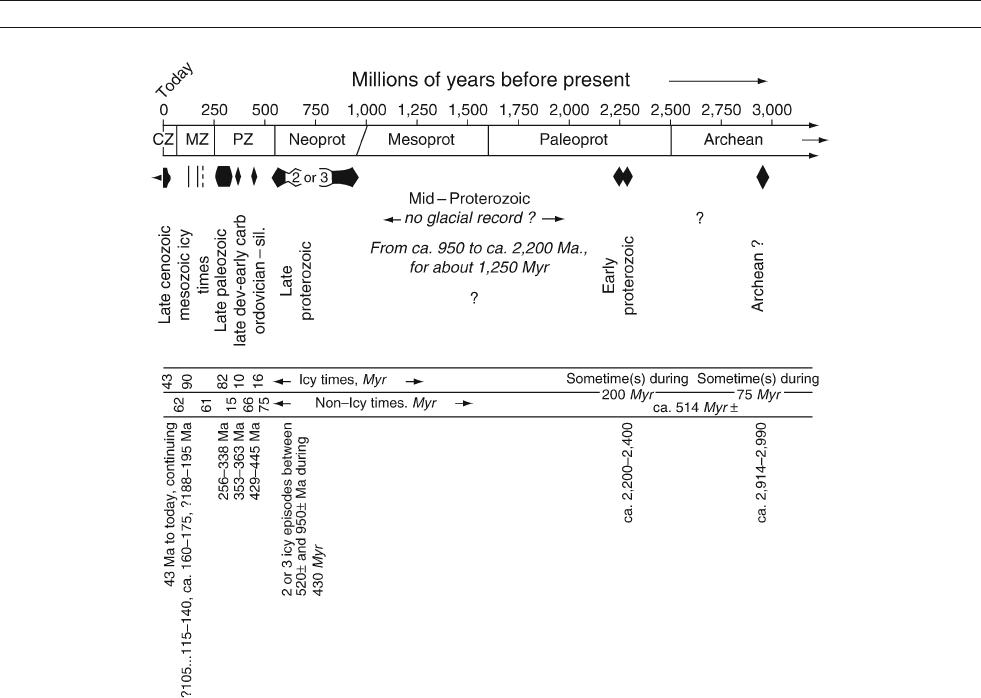
CO
2
levels have steadily decreased, since Archean time. In the
Phanerozoic, the atmospheric CO
2
concentration has varied dras-
tically between icehouse and greenhouse times (Figure I10)
(Berner, 1990, 1991;Veizer,2000; Crowley and Berner, 2001).
These concentrations are buffered by feedback loops involving
water vapor within the hydrosphere and complex relations in
the biosphere (Kump, 2002).
Icehouse characteristics
In general, icehouse conditions occur at times of lower sea
level, less cumulative volcanic activity, more vigorous oceanic
circulation and bottom water oxidation, less diversity in marine
organisms, and deeper levels of the carbonate compensation
depth. Relatively warmer, greenhouse intervals are characterized
by marine transgression, extensive carbonate bank systems,
organic-rich shale basins, marine chert and phosphorite deposi-
tion, and nutrient upwelling (Fischer and Arthur, 1977). During
icehouse intervals, several or all of the tectonic, geochemical,
and astronomical events discussed below coincide. However,
determination of the relative cause and effect of each factor, each
with its own feedback system, is complex. Both terrestrial and
celestial components are involved.
Glaciation to sea level at mid latitudes
The empirical definition of an icehouse state as seen in the geolo-
gic record is the presence of floating sea-ice at mid-latitudes (30
),
and therefore the presence of ice-rafted debris (dropstones) in
marine sediments (Frakes et al., 1992). Glacial ice has likely been
present in high mountains throughout the Phanerozoic but the pre-
servation potential of such alpine glacial deposits is low (Crowell,
1999)(seeIce-rafted debris (IRD); Glacial geomorphology).
Well-mixed and colder oceans
During an icehouse, the deep ocean floor is oxygenated, and
oceans are well-mixed. Icehouse conditions are favored when
continental positioning allows north-south ocean circulation
to bring warm equatorial water into polar latitudes where it eva-
porates and generates snowfall. This was the case during the
Quaternary. Pleistocene oceanic bottom water temperatures were
15
C lower than during the Mesozoic greenhouse (Crowley and
Berner, 2001).
Carbon dioxide in atmosphere is lower
The percent of CO
2
in the atmosphere is lower in icehouse
times, and generally tracks, and partly causes, the net change
in temperature (Berner, 1990). Today’sCO
2
percentage is in
the icehouse range, at 300–370 ppm (Crowley and Berner,
2001). Models show this to be 17% of the Late Cretaceous
greenhouse value, and perhaps only 5% of Cambrian Green-
house CO
2
levels (Figure I10) (Chen and Drake, 1986; Berner,
1990). CO
2
percentage dropped with the Devonian advent of
land plants and resulting accelerated silicate weathering.
Figure I8 Major ice ages on Earth when the extent of continental glaciers was so great that tongues of ice reached the sea. Duration of icy
andnon-icy times is shown in the middle of the figure. CZ = Cenozoic; MZ = Mesozoic; PZ =Paleozoic;NEOPROT = Neoproterozoic;
MESOPROT =Mesoproterozoic;PALEOPROT = Paleoproterozoic (from Crowell, 1999, Figure 1, used by permission of Geological Society of America).
464 “ICEHOUSE” (COLD) CLIMATES
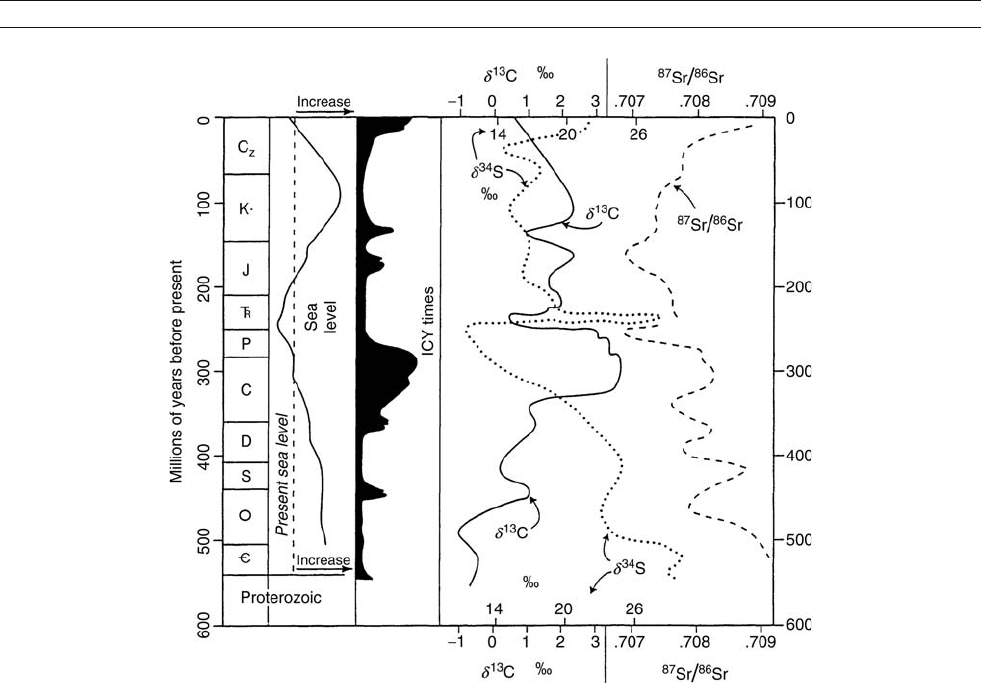
Carbon isotope values are complex
Carbon is fractionated between organic matter (which is rela-
tively concentrated in
12
C) and carbonate (inorganic) carbon
(which is heavier in d
13
C). Mantle carbon and methane (organic
carbon) are both depleted in
13
C. The more sedimentary carbon
that is buried as organic matter, the heavier will be the remaining
carbonate carbon (Knoll, 1991). Further, increased weathering
of sediments that contain isotopically light organic carbon, in
orogenic belts, or from exposed continental shelves during
times of low sea level, will shift the d
13
C ratio in carbonate
sediments to more negative values.
In the Pleistocene, more negative d
13
C values correspond
with times of greater glaciation. In the Neoproterozoic, major
negative d
13
C spikes are found in carbonate rocks deposited
on top of glacial marine sediments.
However, for the Late Paleozoic Ice Age and the Ordovician
glaciation, d
13
C values are heavier than during the intervening
greenhouse intervals (Figure I9). This apparent ambiguity has
caused much controversy.
Global sea level is lower
Sea level is relatively lower during icehouse modes (Figure I9).
At such times, water is stored in glacial ice, causing significant
drops in global sea level on timescales of 10
5
yr (100 kyr). The
extent of sea ice has an important positive feedback on the
albedo or reflectivity of the Earth, which increases as sea level
drops and ice expands. As the albedo increases, the Earth
absorbs less solar radiation, and the climate becomes cooler.
Conversely, during warmer, more humid times, sea level is
high and polar ice is minimal, lowering the Earth’s albedo.
The ultimate long-term (10
8
years – first order) controls on
sea level are tectonic, expressed as the average elevation of
water-displacing, thermally inflated ocean floor, which is itself
a function of the average rate of sea-floor spreading.
Bioherms and evaporites restricted to low latitude:
aragonite seas
During icehouse intervals, bioherms and evaporites are rest-
ricted to less than 20
latitude. There is lower invertebrate
diversity in high latitudes. Like today, aragonite and high-Mg
calcite ooids precipitate in shallow marine environments (as
opposed to low-Mg calcite ooids during greenhouse times)
(Stanley and Hardie, 1998).
Reduced pelagic diversity
Diversity of the pelagic marine realm was reduced (oligotaxy)
during icehouse intervals. Such oligotaxic times fostered
intense blooms of opportunistic pelagic organisms at times of
cumulative lowest diversity (Fischer and Arthur, 1977; Fischer,
1982, 1986).
Figure I9 Carbon (d
13
C), strontium (
87
Sr /
86
Sr), and sulfur (d
34
S) isotopic ratios through Phanerozoic time compared with sea level and icy times.
Cz = Cenozoic; K = Cretaceous; J = Jurassic; Tr = Triassic; P = Permian; C = Carboniferous; D = Devonian; S = Silurian; O = Ordovician; = Cambrian
(from Crowell, 1999, Figure 25; originally modified from Veevers, 1994, Figure 1, used by permission of Geological Society of America).
“ICEHOUSE” (COLD) CLIMATES 465
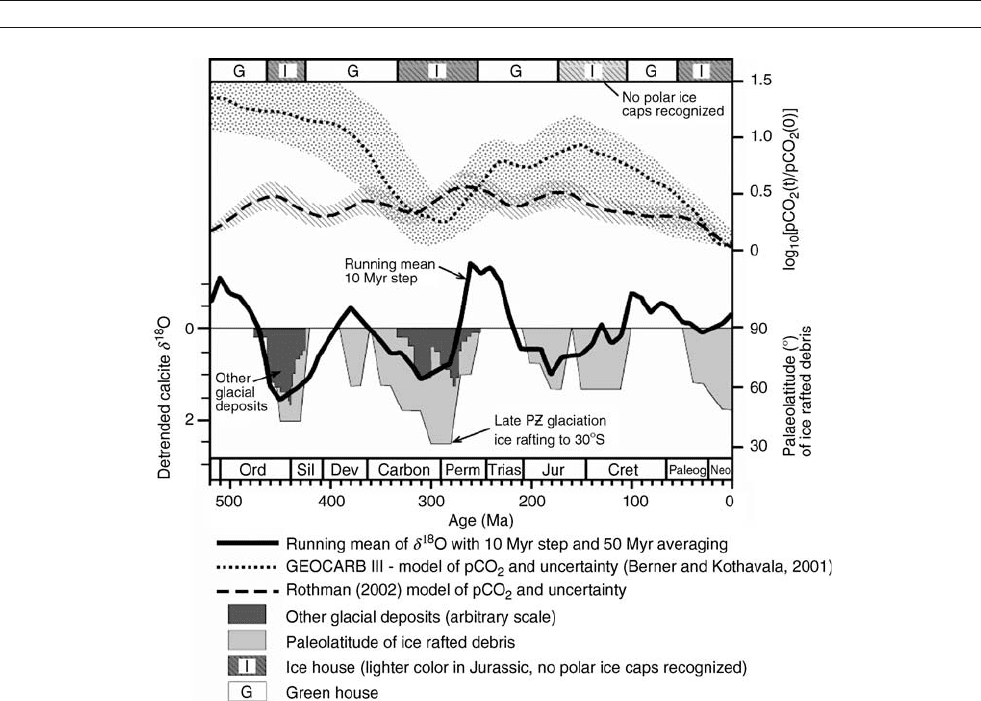
Carbonate compensation depth is deeper
During icehouse intervals, the CCD (carbonate compensation
depth) is relatively deep within the world ocean, caused
by the cooler oceanic temperatures and the resulting greater
solubility of carbonate. Such conditions may not, however,
apply to the Neoproterozoic, before the advent of pelagic car-
bonate-secreting organisms (Ridgwell et al., 2003).
Rates of carbon burial are reduced
In general, rates of carbon burial, or sequestration of organic
carbon, are reduced in icehouse times, because the oceans are
better aerated and the area of dysoxic restricted basins is smal-
ler. The locations of such basins and associated carbon sinks
are determined by plate configuration, global and local sea
level, and by local organic productivity (controlled by upwel-
ling). Low rates of accumulation of marine organic matter in
Late Paleozoic time suggest well-ventilated Icehouse oceans.
Volcanic production of CO
2
is lower
In Phanerozoic cool periods, net production of CO
2
by volcanic
activity is lower than during greenhouse events. Plate tectonic
and mantle events cause these changes in net volcanic eruption
rates, with decreased rates reflecting periods of supercontinents
and slow sea-floor spreading.
Plate tectonic causation
Icehouse climates are favored during times of relatively slow
sea-floor spreading, which, in the Phanerozoic, have been times
of supercontinent persistence. In general, large continents favor
formation of ice sheets (Frakes et al., 1992). For the Late
Paleozoic and Late Cenozoic ice ages, a north-south arrange-
ment of continents, fostering longitudinal ocean circulation,
was a first-order cause of climate cooling.
A decrease in worldwide volcanic activity, with reduction in
CO
2
emission, is controlled by the rate of sea-floor spreading.
Such a decrease is favorable for a long-term icehouse event.
Slower sea-floor spreading leads to lower global sea level,
another icehouse characteristic.
Veevers (1990) suggests that supercontinent cycles are the
ultimate cause of icehouse climates, which occur at times of
maximum continentality and slower sea-floor spreading. Appa-
rent long-term periodicities in global tectonic phenomena and
impact cratering have been linked to motions of the solar sys-
tem through the galaxy (e.g., Rampino and Stothers, 1986).
Figure I10 Phanerozoic climatic indicators and reconstructed pCO
2
levels (adapted from Shaviv and Veizer, 2003, Figure 1). Icehouse and
greenhouse intervals are shown at the top of the diagram. Upper two curves represent estimated pCO
2
from the GEOCARB III CO
2
model
(Berner and Kothavala, 2001) and the model of Rothman (2002). Oxygen isotope values from shells are shown with 10-Myr steps and 50-Myr
averages. This smooths the curve and eliminates the highest readings. Paleolatitude of ice rafted debris and qualitative estimate of other
glacial deposits are shown in the lower part of the diagram.
466 “ICEHOUSE” (COLD) CLIMATES
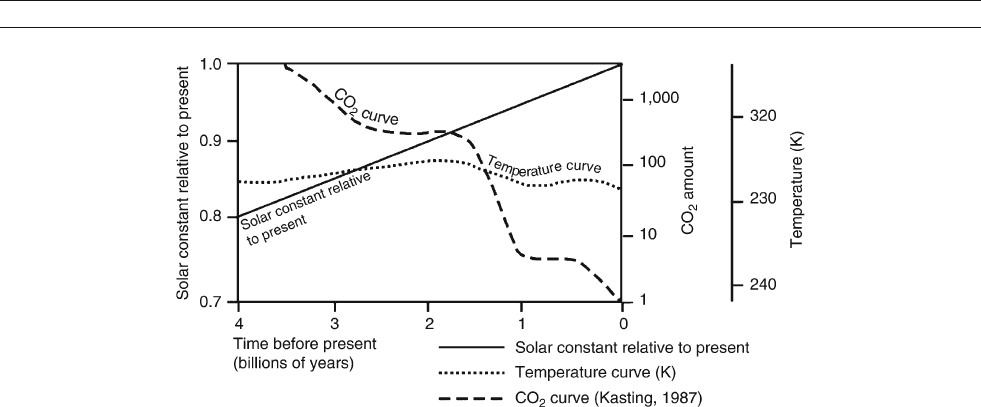
However, Crowell (1999) does not recognize these tectonic
supercycles. The presence or absence of deterministic chrono-
tectonic supercontinent cycles is a recurring point of discussion
in the study of Earth history.
Records of ancient glaciations
Glaciers are manifested differently at different latitudes, and
include ice sheets, valley glacier and piedmont glacier compl-
exes and mountain glaciers. Geological evidence for glaciation
and glacial sedimentation are important to paleoclimatologists
and sedimentologists, because they can indicate former cold cli-
mates (Harland, 1964; Deynoux et al., 1994; Crowell, 1999). Defi-
nitive ancient glacial deposits include poorly sorted diamictites,
which may contain striated clasts and be associated with dropstone
facies in proglacial lakes or seas (Link and Gostin, 1981).
A brief summary of the main icehouse intervals since 1,000
Ma follows. More detail is given in Crowell (1999).
Neoproterozoic (Cryogenian) glacial interval
Late Proterozoic glacial strata are found on all continents. The
first evidence for ice sheets at low latitudes was marshaled by
Harland (1964) who proposed the Great Infra-Cambrian ice
age. Neoproterozoic paleocontinental positions suggest that
most landmasses were at low latitudes, in areas of intense sili-
cate weathering (Evans, 2000). This intense weathering traps
carbonate and lowers global atmospheric CO
2
percentage
(Kirschvink, 1992). Repeated studies have demonstrated low
paleolatitudes for Neoproterozoic glacial marine strata (Sohl
et al., 1999).
The Cryogenian Period of the Neoproterozoic is named for
these icehouse intervals and has been investigated by the Inter-
national Union of Geological Sciences (Knoll and Walter,
1992; Knoll, 2000; Narbonne, 2003).
Only recently have sufficiently accurate geochronologic data
been obtained to place constraints on the Neoproterozoic glacial
intervals, so that issues of synchroneity and extent of specific
glacial advances remain controversial. Figure I12 shows the
time and isotopic constraints, grouped into two broad icehouse
intervals, Sturtian (730–670 Ma) and Marinoan (640–580 Ma),
each tens of millions of years long in duration and each with sev-
eral glaciations. The Marinoan glacial interval is used here in the
inclusive sense (Knoll, 2000) to encompass the Varanger, Ghaub,
and Gaskiers glaciations and is succeeded by the Ediacaran (Ven-
dian) Period. New radiometric ages from glacial strata reveal
multiple ages for ice advance, rather than two synchronous global
ice ages (Bowring et al., 2003;Lundetal.,2003; Calver et al.,
2004;FanningandLink,2004; Hoffmann et al., 2004;Zhouetal.,
2004). Purely lithostratigraphic correlations have been a first start,
but, to be credible, must be verified by geochronology.
Cap carbonates
Neoproterozoic glacial marine diamictites are often overlain
by laminated cap carbonates that have strongly negative d
13
C
values (e.g., Kauffman et al., 1997; Hoffman et al., 1998,
Kennedy et al., 2001). Some cap carbonates contain spectacular
aragonite crystal fans that grew rapidly on the sea floor. The
juxtaposition of glacial (icehouse) deposits with carbonate
(greenhouse) deposits is striking. In the Snowball Earth sce-
nario, which proposes that the world oceans froze entirely over
(Hoffman et al., 1998; Hoffman and Schrag, 2002), cap carbo-
nates play an integral role and are thought to have been depos-
ited rapidly during a post-glacial marine alkalinity event that
was fed by a deeply weathered carbonate-rich regolith formed
during the glaciation.
The severity of Cryogenian climate cycles is represented by
the wide range of d
13
C values from Neoproterozoic carbonates
(Figure I12) (Kaufman et al., 1997; Lorentz et al., 2004). Docu-
mented negative d
13
C isotopic excursions for carbonates imme-
diately above the glacial rocks are as great as 16%, going
from + 10 to 6%, which exceeds the magnitude of Phanero-
zoic excursions (Hoffman and Schrag, 2002). Levels of 6%
suggest near-shutdown of the fractionation of
12
C in organic
matter, as would happen with rapid deposition of shallow-
marine carbonate during post-glacial transgression.
Crowell (1999) points out that these carbonates may not
represent immediately warmed ocean water, but rather, slowly
Figure I11 Variation of surface temperature, solar constant and atmospheric CO
2
over geologic time. Temperature curve refers to average
surface temperature at 35
latitude. Note that CO
2
percentage has been falling steadily since the Archean, while solar output has been
increasing. The net temperature has remained quite constant. Small-scale CO
2
changes, related to icehouse cycles, are superposed on this
decreasing secular trend (simplified from Frakes et al., 1992, Figure 1.1).
“ICEHOUSE” (COLD) CLIMATES 467
